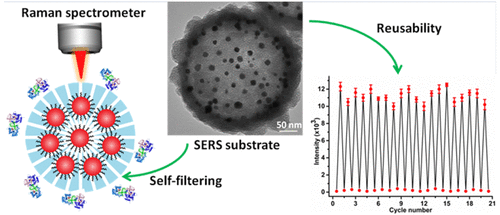当前位置:
X-MOL 学术
›
ACS Appl. Mater. Interfaces
›
论文详情
Our official English website, www.x-mol.net, welcomes your
feedback! (Note: you will need to create a separate account there.)
Synthesis of Multi-Au-Nanoparticle-Embedded Mesoporous Silica Microspheres as Self-Filtering and Reusable Substrates for SERS Detection
ACS Applied Materials & Interfaces ( IF 8.3 ) Pub Date : 2017-11-22 00:00:00 , DOI: 10.1021/acsami.7b16618 Miao Chen 1 , Wen Luo 1 , Zhimin Zhang 1 , Ranhao Wang 1 , Yuqiu Zhu 1 , Hua Yang 1 , Xiaoqing Chen 1, 2
ACS Applied Materials & Interfaces ( IF 8.3 ) Pub Date : 2017-11-22 00:00:00 , DOI: 10.1021/acsami.7b16618 Miao Chen 1 , Wen Luo 1 , Zhimin Zhang 1 , Ranhao Wang 1 , Yuqiu Zhu 1 , Hua Yang 1 , Xiaoqing Chen 1, 2
Affiliation

|
Surface-enhanced Raman-scattering-based (SERS-based) biosensing in biological fluids is constrained by nonspecific macromolecule adsorptions and disposable property of the SERS substrate. Here, novel multi-Au-nanoparticle-embedded mesoporous silica microspheres (AuNPs/mSiO2) were prepared using a one-pot method, which served as reliable substrates for SERS enhancement associated with salient features of self-filtering ability and reusability. The fabrication and physical characterization of AuNPs/mSiO2 microspheres were discussed, and SERS activity of this novel substrate was investigated by using 4-mercaptobenzoic acid (4-MBA) as Raman probe. The responses of our substrates to Raman intensities exhibited a SERS enhancement factor of 2.01 × 107 and high reproducibility (relative standard deviation of 6.13%). Proof-of-concept experiments were designed to evaluate the self-filtering ability of the substrates in bovine serum albumin (BSA) and human serum solution, separately. The results clearly demonstrate that mesoporous SiO2 can serve as a molecular sieve via size exclusion and avoid Raman signal interference of biomacromolecules in biological fluids. Subsequently, feasibility of practical application of AuNPs/mSiO2 microspheres was assessed by quantitative detection of methotrexate (MTA) in serum. The method exhibited good linearity between 1 and 110 nM with the correlation coefficients of 0.996, which proved that the obtained AuNPs/mSiO2 microspheres were good SERS substrates for determination of small biomolecules directly in biological fluids without need of manipulating samples. In addition, the substrate maintained its SERS response during multiple cycles, which was evaluated by recording Raman signals for 4-MBA before and after thermal annealing, thereby demonstrating the high thermostability and satisfactory reusability. These results offered the AuNPs/mSiO2 microspheres attractive advantages in their SERS biosensing.
中文翻译:

含金-纳米粒子的中孔二氧化硅微球的合成作为自过滤和可重复使用的底物用于SERS检测
生物流体中基于表面增强拉曼散射(基于SERS)的生物传感受到非特异性大分子吸附和SERS基底的可弃性的约束。在这里,使用一锅法制备了新型的多金纳米粒子包埋的介孔二氧化硅微球(AuNPs / mSiO 2),可作为SERS增强的可靠底物,并具有自过滤能力和可重复使用性的显着特征。讨论了AuNPs / mSiO 2微球的制备和物理表征,并以4-巯基苯甲酸(4-MBA)为拉曼探针研究了该新型底物的SERS活性。我们的底物对拉曼强度的响应显示出SERS增强因子为2.01×10 7和高重现性(相对标准偏差为6.13%)。设计概念验证实验以分别评估牛血清白蛋白(BSA)和人血清溶液中底物的自过滤能力。结果清楚地表明,介孔SiO 2可通过尺寸排阻充当分子筛,并避免了生物大分子在生物流体中的拉曼信号干扰。随后,通过定量检测血清中的甲氨蝶呤(MTA)评估了AuNPs / mSiO 2微球实际应用的可行性。该方法表现出良好的线性度,介于1和110 nM之间,相关系数为0.996,证明所获得的AuNPs / mSiO 2微球是直接在生物流体中测定小生物分子的良好SERS底物,而无需处理样品。另外,基板在多个循环中保持其SERS响应,可以通过在热退火前后记录4-MBA的拉曼信号来评估该响应,从而证明了其高的热稳定性和令人满意的可重复使用性。这些结果为AuNPs / mSiO 2微球在其SERS生物传感中提供了诱人的优势。
更新日期:2017-11-22
中文翻译:

含金-纳米粒子的中孔二氧化硅微球的合成作为自过滤和可重复使用的底物用于SERS检测
生物流体中基于表面增强拉曼散射(基于SERS)的生物传感受到非特异性大分子吸附和SERS基底的可弃性的约束。在这里,使用一锅法制备了新型的多金纳米粒子包埋的介孔二氧化硅微球(AuNPs / mSiO 2),可作为SERS增强的可靠底物,并具有自过滤能力和可重复使用性的显着特征。讨论了AuNPs / mSiO 2微球的制备和物理表征,并以4-巯基苯甲酸(4-MBA)为拉曼探针研究了该新型底物的SERS活性。我们的底物对拉曼强度的响应显示出SERS增强因子为2.01×10 7和高重现性(相对标准偏差为6.13%)。设计概念验证实验以分别评估牛血清白蛋白(BSA)和人血清溶液中底物的自过滤能力。结果清楚地表明,介孔SiO 2可通过尺寸排阻充当分子筛,并避免了生物大分子在生物流体中的拉曼信号干扰。随后,通过定量检测血清中的甲氨蝶呤(MTA)评估了AuNPs / mSiO 2微球实际应用的可行性。该方法表现出良好的线性度,介于1和110 nM之间,相关系数为0.996,证明所获得的AuNPs / mSiO 2微球是直接在生物流体中测定小生物分子的良好SERS底物,而无需处理样品。另外,基板在多个循环中保持其SERS响应,可以通过在热退火前后记录4-MBA的拉曼信号来评估该响应,从而证明了其高的热稳定性和令人满意的可重复使用性。这些结果为AuNPs / mSiO 2微球在其SERS生物传感中提供了诱人的优势。











































 京公网安备 11010802027423号
京公网安备 11010802027423号